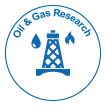Multivariate Power Law Modelling of Apparent Viscosity of Synthetic-Based Mud Used in High-Temperature Gas Wells Using Marsh Funnel and Mud Density Test Results
Received Date: Sep 30, 2023 / Published Date: Mar 17, 2025
Abstract
Despite intensive efforts to diversify the global reliance on fossil fuel, it remains one of the foremost sources of energy. This has led to production activities advancing into very difficult areas such as deep sea, and hig-htemperature/ high-pressure wells. This in turn puts the drilling team in the spotlight as their failure would result in great loss. Rheology is the aspect of science that seeks to understand the behaviour of substances when subjected to different forces. Viscosity measures the extent to which a given fluid resists the tendency to flow. Lucky proposed a modification to the Bingham plastic model which when applied to two samples of synthetic-based muds performed better than the traditional Bingham plastic and power law models. The model included a dimensionless correction factor that increased the accuracy of the model. There is therefore need for more rigorous testing of the model and consequent adoption of the model for field operations within the range of applicability that the testing proves efficient for operations. Therefore, the impact of mud weight in the prediction of plastic viscosity, yield point or apparent viscosity is minimal. The model in this work was obtained for a specific synthetic based mud used in a high-temperature gas well and should be used within the specific conditions that apply to its derivation. The degree of applicability of the proposed model should be determined to ascertain the conditions and range of values within which it gives the best possible predictions to optimize its use for field operations.
Keywords: Power law; Gas well; Marsh funnel; Mud density test; Viscosity
Citation: Ekanem P (2025) Multivariate Power Law Modelling of Apparent Viscosity of Synthetic-Based Mud used in High-Temperature Gas Wells using Marsh Funnel and Mud Density Test Results. Oil Gas Res 11: 398.
Copyright: © 2025 Ekanem P. This is an open-access article distributed under the terms of the Creative Commons Attribution License, which permits unrestricted use, distribution and reproduction in any medium, provided the original author and source are credited.
Select your language of interest to view the total content in your interested language
Share This Article
Recommended Journals
Open Access Journals
Article Usage
- Total views: 470
- [From(publication date): 0-0 - Dec 19, 2025]
- Breakdown by view type
- HTML page views: 361
- PDF downloads: 109
